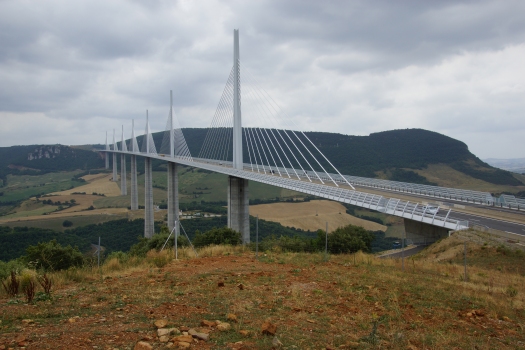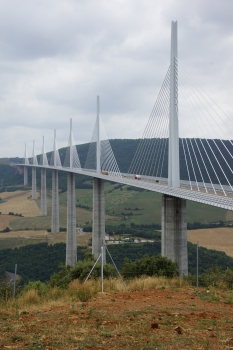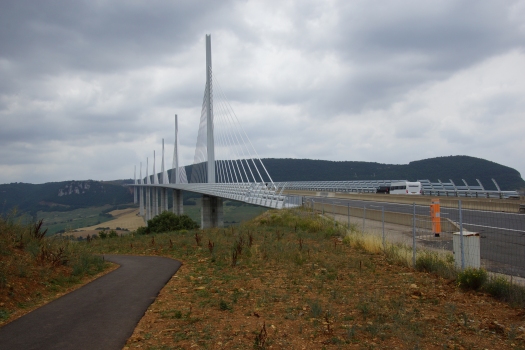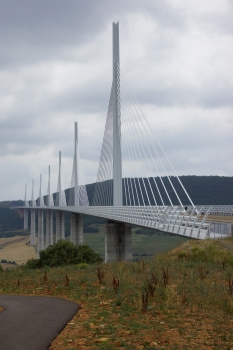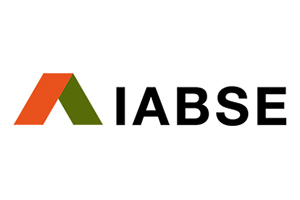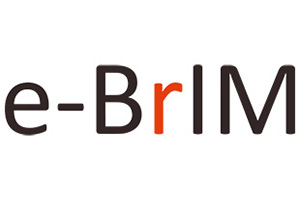General Information
| Name in local language: | Viaduc de Millau |
|---|---|
| Beginning of works: | 16 October 2001 |
| Completion: | 14 December 2004 |
| Duration of works: | 38 months |
| Status: | in use |
Project Type
| Structure: |
Multiple-span cable-stayed bridge |
|---|---|
| Function / usage: |
Motorway bridge / freeway bridge |
| Structure: |
Cable-stayed bridge with semi-fan system |
| Material: |
Steel bridge |
| Support conditions: |
for registered users |
| Plan view: |
Structurae Plus/Pro - Subscribe Now! |
| Construction method: |
deck: Longitudinal launching with temporary cable-stays |
| Material: |
Structurae Plus/Pro - Subscribe Now! |
| Construction method: |
piers: Climbing formwork |
| Secondary structure(s): |
Structurae Plus/Pro - Subscribe Now! |
| Material: |
Structurae Plus/Pro - Subscribe Now! |
| Secondary structure(s): |
Structurae Plus/Pro - Subscribe Now! |
Awards and Distinctions
| 2006 |
award winner
for registered users |
|---|---|
|
for registered users |
Location
| Location: |
Millau, Aveyron (12), Occitanie, France Creissels, Aveyron (12), Occitanie, France |
|---|---|
| Address: | A 75 |
| Carries: |
|
| Crosses: |
|
| Part of: | |
| Next to: |
Centre d'information du viaduc de Millau
|
| Near: |
Millau Viaduct Toll Gate (2004)
|
| Coordinates: | 44° 5' 6" N 3° 1' 18" E |
Technical Information
Dimensions
| total length | 2 460 m | |
| span lengths | 204 m - 6 x 342 m - 204 m | |
| number of spans | 8 | |
| horizontal radius of curvature | 20 000 m | |
| deck | deck depth | 4.20 m |
| height above valley floor or water | 270 m | |
| total width | 32.050 m | |
| longitudinal slope | 3.025 % | |
| pier P1 | height | 94.50 m |
| pier P2 | height | 244.96 m |
| pier P3 | height | 221.05 m |
| pier P4 | height | 144.21 m |
| pier P5 | height | 136.42 m |
| pier P6 | height | 111.94 m |
| pier P7 | height | 77.56 m |
| pylons | pylon height (above deck) | 88.92 m |
| pylon height (above ground) | max. 343 m |
Quantities
| volume of earthworks | 350 000 m³ | |
| deck | structural steel | S355: 23 500 t S460: 12 500 t |
| foundation slabs | concrete volume | 13 000 m³ |
| reinforcing steel | 1 300 t | |
| foundations | reinforcing steel | 13 450 t |
| piers | concrete volume | 53 000 m³ |
| prestressing steel | 200 t | |
| reinforcing steel | 10 000 t | |
| piles | concrete volume | 6 000 m³ |
| reinforcing steel | 1 200 t | |
| pylons | structural steel | S355: 3 200 t S460: 1 400 t |
| stay cables | steel for cable-stays | 1 500 t |
| temporary works | structural steel | S 355: 3 200 t S 460: 3 200 t |
| concrete volume | 7 500 m³ | |
| reinforcing steel | 400 t |
Cost
| cost of construction | Euro 300 000 000 |
Materials
| deck |
steel
|
|---|---|
| piers |
reinforced concrete
|
| pylons |
steel
|
| abutments |
reinforced concrete
|
| stay cables |
steel
|
| pier heads |
prestressed concrete
|
Chronology
| 1987 | CETE (Aix-en-Provence) establishes the first possible alignments for the A75 at Millau. |
|---|---|
| 1990 | Decision by the ministry to cross the Tarn valley by a 2500-meter long bridge. |
| 1993 — 1994 | Seven architectural offices and eight engineering offices are consulted separately for proposals. |
| 1995 — 1996 | Second design phase with five groups each associating an architecture and engineering office. |
| 1996 | The jury retains the solution proposed by Lord Norman Foster in association with Sogelerg. |
| 1998 | The decision is made to operate the Millau Viaduct under a concession agreement. |
| 2000 | Competition is launched for the concession/construction tender. |
| March 2001 | Eiffage is awarded the first prize of the competition and declared concessionaire. |
| May 2001 | The construction contract is signed. |
| August 2001 | The concession is awarded to Eiffage. |
| 16 October 2001 | Construction begins. |
| November 2002 | Pier P2 (to be the highest) reaches 100 meters in height. |
| 26 February 2003 | Launching of the deck commences. |
| 28 May 2003 | Pier P2 surpasses the height of 180 m and thus becomes the highest pier in the world, a record previously held by the Kochertal Viaduct. The record will be broken again when the highest pier reaches 245 meters. |
|
25 August 2003
— 26 August 2003 |
Launching phase L4. |
| November 2003 | Completion of piers. |
| 26 March 2004 | Launching phase L10 from the south end. The deck reaches Pier P3. |
|
Night of 4 April 2004
— 5 April 2004 |
The metal deck is launched onto P2, the highest pier in the world. The launching operation is slowed down by wind and mist which perturb the laser guidance system. A this phase, 1 947 m of deck have been launched. |
| 20 April 2004 | End of launching of the deck from the north side. The end of the canitlever reaching out beyond pier P2 is at midspan over the Tarn. Two launch phases remain from the south side. |
| 28 May 2004 | The deck is completed. |
| End of July 2004 | Completion of the construction of the pylons. |
| November 2004 | Expected completion of the dismantling of the temporary piers. |
| 17 November 2004 | Load testing begins with a total load of 920 tons. |
| 14 December 2004 | Inauguration by President Jacques Chirac. |
| 16 December 2004, 09:00 | Opened to traffic. |
| 2006 | Outstanding Structure Award 2006 (IABSE) |
Notes
The pier dimensions are as follows:
- In the longitudinal direction: 16 to 17 meters
- In the lateral direction: variable from 10 meters at the pylon head to 27 at the foot of the highest pier.
The piers split into two separate shafts around 90 meters below deck level. Each shaft is vertically post-tensioned using 8 19T15S cables.
The shaft dimension in the longitudinal direction are also variable from 5 meters at the head to 8.60 meters where the join.
The total height of the pylons is 87 meters. Their shape is that of an inverted Y in the longitudinal direction. The height of the legs of the Y is 38 meters.
The deck is cable-stayed. The stays are arranged in two planes with 11 stays each in a sem-fan arrangement. Deck anchors are spaced at 12.51 meters.
Each pylon has a weight of 650 tons and a height of nearly 89 meters. The assembly is done behind the abutments. They are then transported horizontally on Kamag trucks to the final location where they are lifted and rotated into place using a temporary structure.
Design and Construction of the Millau Viaduct
The Millau Bridge and the Rion-Antirion Bridge are the most modern and most important examples for series of cable-stayed bridges. They answer the main questions for series individually: – How can the inner towers be stabilized to avoid too large beam deflections due to spanwise live loads? – How can the changes in beam lengths of these long bridges, e. g. due to temperature, be taken into account, together with longitudinal forces, e.g due to breaking, together with the forces from an earthquake?
In 2004 the large viaduct of Millau was opened for traffic, thereby closing the last gap in the second north–south highway A 75. The bridge has earned ist title „Record Bridge“ not only because it is the highest in the world, crossing the Tarn River at a height of 270 m, but also the construction period of only 38 months and the costs of about € 400 million are outstanding. For the second north–south highway the main obstacle was the wide valley of the Tarn River near the city of Millau, well-known for ist seemingly endless queues during the summer. It was decided to cross the valley by a 2 460 m long viaduct. In 1996 a series of cable-stayed bridges with two side spans of 204 m, and six main spans of 342 m was selected. For the financial success of the concession company, it was important to keep the construction period to a minimum in order to receive tolls as early as possible. For this reason, the French contractor Eiffel Construction Métallique proposed an alternate with a steel beam and steel towers above deck against the tender design of a post-tensioned concrete bridge. This alternate was selected in March 2001 and construction started in October 2001. The advantages of the steel design against the original concrete design are:
- light-weight and slenderness of the beam (36 t against 120 t)
- reduction of the depth of the beam to 4.2 m, meaning smaller wind loads
- improved safety: less work at great height due to pre-assembly on ground and incremental launching construction
- minimizing the number of stay cables and the size of foundations
- reduction in total costs – the over-riding advantage.
Within two and a half years nearly 43 t of steel were fabricated for the beam, the towers and the auxiliary piers. For the complete design phase Michel Virlogeux was the engineer- in-charge for the French Highway Authority SETRA, and during the construction phase he was an important advisor.
Design
The Millau Bridge has a total length of 2 460 m and comprises eight spans: two side spans with 204 m and six inner spans with 342 m. The cross-section consists of a steel box with orthotropic deck, two vertical inner webs and two inclined outer plates. The vertical webs are required for construction by incremental launching, and the triangular outside boxes create a streamlined cross-section which reduces the wind load on the bridge. On the outside of the beam, wind shields are installed which prevent the overturning of high-sided vehicles. The rounded edges on both outsides improve the aerodynamic behavior and the appearance. Due to the great height above the valley a central girder, with one cable plane only, was the most effective design for avoiding twin piers. The required torsional stiffness is provided by the box girder. Governing the design of the bridge was the condition that the up to 230 m high piers are stiff enough to carry unsymmetrical loads in the longitudinal direction. Also they have to be flexible enough to follow the beam’s longitudinal changes due to temperature. The solution is a strong concrete box girder for the piers with a vertical slot underneath the beam. This bisectioning of the box provides for the required flexibility. The 87 m high towers above deck form stiff A-frames in the longitudinal direction. The spread legs of the towers meet at the beam the spread upper pier halves. In this way, an overall system from pier and tower is created which converts the moment from loads acting at the tower tips into a couple of tension and compression and thus restrains the tower head. The 90 m long pier shafts are vertically post-tensioned to counteract the tensile stresses due to wind in the inner piers and due to temperature changes in the outer piers. Bearings are located between the steel girder and the concrete piers, which are stressed down against uplift. Unsymmetrical loads and extreme winds cause support reactions on each pier of up to 100 MN. A new type of spherical bearing was used. The towers above deck are made from steel to make them as light and slender as possible. The central cable plane is anchored at the tower heads between longitudinal steel plates. Due to architectural reasons the towers extend beyond the upper cables.
Construction
Piers
The piers have varying cross-sections, but dimensions were selected in such a way that they could be formed easily. Four sides have constant dimensions, and the others vary uniformly in each construction section. This permits construction with outer jumping forms and inner forms which are stepwise lifted by the tower crane. Sliding forms could have made the correct positioning of the built-in items difficult.
Beam
About 2100 stiffened panels, four per work day, were fabricated from plates and stiffeners in the shops of Eiffel Construction Métallique in Lauterbourg (Alsace). After transportation to site they were welded in the two 170 m long pre-assembly yards. The central boxes were pre-welded ahead in Fos-sur-Mer. Up to 75 welders were working in each pre-assembly yard.
Launching the beam
The detailed design and construction engineering of the steel parts – beam, towers and auxiliary piers – was provided by the consultant Greisch from Liège, Belgium. The engineer-in-charge was Jean- Marie Crémer. During launching from both abutments several special measures were introduced to control the large cantilever moments. The spans were reduced by half with temporary telescopic piers, a launching nose was used and the front tower with some of the final stay cables was launched together with the beam. These cables were not ad- justed during launching! After joint closure on 28 May 2004, the remaining towers and stay cables were installed and the auxiliary piers removed. The steel beams were launched from both ends at the same time with a closure joint above the Tarn River. In the center of the large span trussed auxiliary truss piers were installed with the exception of the center span which was bridged by cantilevering from both sides. The launching bearings on top of the piers with a distance of 20 m reduced the beam moments quite significantly in the ratio of span lengths (151 / 171)² = 0.78.
The auxiliary piers are built from prefabricated sections with 12 m heights. They are designed like a crane. The elements prefabricated on the ground from steel sections are lifted with an inside lifting device in such way that the next sections could be installed from underneath and also lifted until these telescoping auxiliary piers reached a height of up to 175 m. Their highest load came to 7 000 t roughly equal to the total weight of the Eifel Tower. The final piers were only provided with an auxiliary scaffolding for launching. A unique characteristic of this launching was that, for cost rea- sons, the pre-assembly yard was located at the level of the future road gradient, 4.8 m above the final bridge deck elevation. A shortened view during launching shows the elasticity of the steel beam by overcoming the gradient offset. Each of the two beam halves was launched over an auxiliary pier and a launching nose across the outer side spans. After that the final tower was installed at the front end as auxiliary support, but with a reduced height of 70 m instead of 87 m to minimize the transverse wind loads during launching. The highest wind speed permitted during launching was 3 km/h. Due to the extreme heights of the piers the friction forces during launching had to be equalized, so on top of each pier two active launching bearings were installed in each support axis. Horizontal hydraulic jacks acted between the beam and the piers in such a way that the pier tips remained in place during launching, centrally controlled by sensors. Finally the center span was bridged from each side with cantilevers, supported by towers. The design and construction on site was an extraordinary engineering achievement.
Towers
After the steel beam was in place, the remaining steel towers were pre-assembled behind the abutments. Each tower was then moved with crawler cranes over the bridge beam to ist final position. The total weight of such a convoy came to 8 MN, thus acting as a test loading. The towers were lifted from their horizontal position with the help of a temporary guyed tower. Finally, they were connected with the beam, and the stay cables were installed.
Completed Bridge
The Millau Bridge is an important example for a series of cablestayed bridges. A structure with impressive elegance has been built in an impressive landscape, where it gracefully crosses the valley at great height.
Excerpt from: Svensson, Holger; Cable-Stayed Bridges, Wilhelm Ernst & Sohn Verlag für Architektur und technische Wissenschaften GmbH, Berlin (Germany), ISBN 343302992X; pp. 411-417. References to figures and literature were omitted.
Excerpt from Wikipedia
The Millau Viaduct (French:le Viaduc de Millau, IPA: [vjadyk də mijo]) is a cable-stayed bridge that spans the gorge valley of the Tarn near Millau in southern France. In a Franco-British partnership, it was designed by the French structural engineer Michel Virlogeux and English architect Norman Foster. As of November 2018, it is the tallest bridge in the world, having a structural height of 336.4 meters (1,104 ft).
The Millau Viaduct is part of the A75–A71 autoroute axis from Paris to Béziers and Montpellier. The cost of construction was approximately € 394 million. It was built over three years, formally inaugurated on 14 December 2004, and opened to traffic two days later on 16 December. The bridge has been consistently ranked as one of the great engineering achievements of all time and received the 2006 Outstanding Structure Award from the International Association for Bridge and Structural Engineering.
History
In the 1980s, high levels of road traffic near Millau in the Tarn valley were causing congestion, especially in the summer due to holiday traffic on the route from Paris to Spain. A method of bypassing Millau had long been considered, not only to ease the flow and reduce journey times for long-distance traffic but also to improve the quality of access to Millau for its local businesses and residents. One of the solutions considered was the construction of a road bridge to span the river and gorge valley. The first plans for a bridge were discussed in 1987 by CETE, and by October 1991 the decision was made to build a high crossing of the Tarn by a structure of around 2,500 meters (8,200 ft) in length. During 1993–1994, the government consulted with seven architects and eight structural engineers. From 1995 to 1996, a second definition study was made by five associated architect groups and structural engineers. In January 1995, the government issued a declaration of public interest to solicit design approaches for a competition.
In July 1996 the jury decided in favor of a cable-stayed design with multiple spans, as proposed by the Sogelerg consortium led by Michel Virlogeux and Norman Foster. The decision to proceed by grant of contract was made in May 1998; then in June 2000, the contest for the construction contract was launched, open to four consortia. In March 2001, Eiffage established the subsidiary Compagnie Eiffage du Viaduc de Millau (CEVM) and was declared the winner of the contest and awarded the prime contract in August.
Possible routes
In initial studies, four potential options were examined:
- Great Eastern (French:grand Est) — passing east of Millau and crossing the valleys of the Tarn and Dourbie on two very high and long bridges (spans of 800 and 1,000 meters) whose construction was acknowledged to be problematic. This option would have allowed access to Millau only from the Larzac plateau, using the long and tortuous descent from La Cavalerie. Although this option was shorter and better suited to through traffic, it did not satisfactorily serve the needs of Millau and its area.
- Great Western (French:grand Ouest) — longer than the eastern option by 12 kilometers (7.5 mi), following the Cernon valley. Technically easier (requiring four viaducts), this solution was judged to have negative impacts on the environment, in particular on the picturesque villages of Peyre and Saint-Georges-de-Luzençon. It was more expensive than the preceding option and served the region badly.
- Near RN9 (French:proche de la RN9) — would have served the town of Millau well, but presented technical difficulties,[ clarification needed], and would have had a strong impact on existing or planned structures.
- Intermediate (French:médiane), west of Millau — was supported by local opinion, but presented geological difficulties, notably on the question of crossing the valley of the Tarn. An expert investigation concluded that these obstacles were not insurmountable.
The fourth option was selected by ministerial decree on 28 June 1989. It encompassed two possibilities:
- the high solution, envisaging a 2,500-metre-long (8,200 ft) viaduct more than 200 meters (660 ft) above the river;
- the low solution, descending into the valley and crossing the river on a 200-meter-long (660 ft) bridge, then a viaduct of 2,300 meters (7,500 ft), extended by a tunnel on the Larzac side.
After long construction studies by the Ministry of Public Works, the low solution was abandoned because it would have intersected the water table, had a negative impact on the town, cost more, and lengthened the driving distance. The choice of the 'high' solution was decided by ministerial decree on 29 October 1991.
After the choice of the high viaduct, five teams of architects and researchers worked on a technical solution. The concept and design for the bridge was devised by French designer and structural engineer Dr. Michel Virlogeux. He worked with the Dutch engineering firm ARCADIS, responsible for the structural engineering of the bridge.
Choosing the definitive route
The 'high solution' required the construction of a 2,500-metre-long (8,200 ft) viaduct. From 1991 to 1993, the structures division of Sétra, directed by Michel Virlogeux, carried out preliminary studies and examined the feasibility of a single structure spanning the valley. Taking into account technical, architectural, and financial issues, the Administration of Roads opened the question for competition among structural engineers and architects to widen the search for realistic designs. By July 1993, seventeen structural engineers and thirty-eight architects applied as candidates for the preliminary studies. With the assistance of a multidisciplinary commission, the Administration of Roads selected eight structural engineers for a technical study and seven architects for the architectural study.
Choice of technical design
Simultaneously, a school of international experts representing a wide spectrum of expertise (technical, architectural, and landscape), chaired by Jean-François Coste, was established to clarify the choices that had to be made. In February 1995, on the basis of proposals of the architects and structural engineers, and with support of the school of experts, five general designs were identified.
The competition was relaunched: five combinations of architects and structural engineers, drawn from the best candidates of the first phase, were formed; each was to conduct in-depth studies of one of the general designs. On 15 July 1996, Bernard Pons, minister of Public Works, announced the decision of the jury, which was constituted of elected artists and experts, and chaired by Christian Leyrit, the director of highways. The solution of a multiple-span viaduct cable-stayed bridge, presented by the structural engineering group Sogelerg, Europe Etudes Gecti, and Serf, and the architects Foster + Partners was declared the best.
Detailed studies were carried out by the successful consortium, steered by the highways authority until mid-1998. After undergoing wind tunnel tests, the shape of the road deck was altered, and detailed corrections were made to the design of the pylons. When the details were eventually finalized, the whole design was approved in late 1998.
Contractors
Once the Ministry of Public Works had taken the decision to offer the construction and operation of the viaduct as a grant of contract, an international call for tenders was issued in 1999. Five consortia tendered:
- Compagnie Eiffage du Viaduc de Millau (CEVM), a new subsidiary created by Eiffage;
- PAECH Construction Enterprise, Poland;
- a consortium led by the Spanish company Dragados, with Skanska, Sweden, and Bec, France;
- Société du Viaduc de Millau, including the French companies ASF, Egis Projects, GTM Construction, Bouygues Travaux Publics, SGE, CDC Projets, Tofinso, and the Italian company Autostrade;
- a consortium led by Générale Routière, with Via GTI (France) and Cintra, Nesco, Acciona, and Ferrovial Agroman (Spain).
The piers were built with Lafarge high-performance cement. The pylons of the Millau Viaduct, which are the tallest elements (the tallest pylon – 244.96 meters (803.7 ft)) were produced and mounted by PAECH Construction Enterprise from Poland.
The Compagnie Eiffage du Viaduc de Millau, working with the architect Sir Norman Foster, was successful in obtaining the tender. Because the government had already taken the design work to an advanced stage, the technical uncertainties were considerably reduced. A further advantage of this process was to make negotiating the contract easier, reducing public expense, and speeding up construction, while minimizing such design work as remained for the contractor.
All the member companies of the Eiffage group had some role in the construction work. The construction consortium was made up of the Eiffage TP company for the concrete part, the Eiffel company for the steel roadway (Gustave Eiffel built the Garabit viaduct in 1884, a railway bridge in the neighboring Cantal département), and the Enerpac company for the roadway's hydraulic supports. The engineering group Setec has authority in the project, with SNCF engineering having partial control.[ clarification needed] Appia (company) [fr] was responsible for the job of the bituminous road surface on the bridge deck, and Forclum for electrical installations. Management was handled by Eiffage Concessions.
The only other business that had a notable role on the building site was Freyssinet, a subsidiary of the Vinci Group specializing in prestressing. It installed the cable stays and put them under tension, while the prestress division of Eiffage was responsible for prestressing the pillar heads.
The steel road deck and the hydraulic action of the road deck were designed by the Walloon engineering firm Greisch from Liège, Belgium, also an information and communication technologies (ICT) company of the Walloon Region. They carried out the general calculations and the resistance calculations for winds of up to 225 kilometers per hour (140 mph). They also applied the launching technology.
The sliding shutter technology for the bridge piers came from PERI.
Costs and resources
The bridge's construction cost up to €394 million, with a toll plaza 6 kilometers north of the viaduct, costing an additional €20 million. The builders, Eiffage, financed the construction in return for a concession to collect the tolls for 75 years, until 2080. However, if the concession yields high revenues, the French government can assume control of the bridge as early as 2044.
The project required about 127,000 cubic meters of concrete, 19,000 tonnes of steel for the reinforced concrete, and 5,000 tonnes of pre-stressed steel for the cables and shrouds. The builder claims that the lifetime of the bridge will be at least 120 years.
Opposition
Numerous organizations opposed the project, including the World Wildlife Fund (WWF), France Nature Environnement, the national federation of motorway users, and Environmental Action. Opponents advanced several arguments:
- The westernmost route would be better, longer by 3 kilometers (1.9 mi), but a third of the cost with its three more conventional structures.
- The objective of the viaduct would not be achieved; because of the toll, the viaduct would be little used, and the project would not solve Millau's congestion problems.
- The project would never break even; toll income would never amortize the initial investment, and the contractor would have to be supported by subsidies.
- The technical difficulties were too great, and the bridge would be dangerous and unsustainable; the pylons, sitting on the shale of the Tarn Valley, would not support the structure adequately.
- The viaduct represented a detour, reducing the number of visitors passing through Millau and slowing its economy.
Construction
The viaduct under construction, seen from the south in early 2004
Two weeks after the laying of the first stone on December 14, 2001, the workers started digging the deep shafts. There were four shafts per pylon; 15 meters deep and 5 meters in diameter, assuring the stability of the pylons. At the bottom of each pylon, a tread of 3–5 meters in thickness was installed to reinforce the effect of the deep shafts. The 2,000 cubic meters of concrete necessary for the treads were poured at the same time.
In March 2002, the pylons emerged from the ground. The speed of construction then rapidly increased. Every three days, each pylon increased in height by 4 meters. This performance was mainly due to sliding shuttering. Thanks to a system of shoe anchorages and fixed rails in the heart of the pylons, a new layer of concrete could be poured every 20 minutes.
The bridge road deck was constructed on land at the ends of the Viaduct, and rolled lengthwise from one pylon to the next, with eight temporary towers providing additional support. The movement was accomplished by a computer-controlled system of pairs of wedges under the deck; the upper and lower wedges of each pair pointing in opposite directions. These were hydraulically operated, and moved repeatedly in the following sequence: the lower wedge slides under the upper wedge, raising it to the roadway above, and then forcing the upper wedge still higher to lift the roadway. Both wedges move forward together, advancing the roadway a short distance. The lower wedge retracts from under the upper wedge, lowering the roadway and allowing the upper wedge to drop away from the roadway; the lower wedge then moves back all the way to its starting position. There is now a linear distance between the two wedges equal to the distance forward the roadway has just moved. The upper wedge moves backward, placing it further back along the roadway, adjacent to the front tip of the lower wedge, and ready to repeat the cycle and advance the roadway by another increment. It worked at 600 millimeters per cycle which was roughly four minutes long.
The mast pieces were driven over the new road deck lying down horizontally. The pieces were joined to form the one complete mast, still lying horizontally. The mast was then tilted upwards, as one piece, at one time in a tricky operation. In this way, each mast was erected on top of the corresponding concrete pylon. The stays connecting the masts and the deck were then installed, and the bridge was tensioned overall, and weight tested. After this, the temporary pylons could be removed.
Construction records
The construction Millau Viaduct broke several records:
- The highest pylons in the world: pylons P2 and P3, 244.96 meters and 221.05 meters in height respectively, broke the French record previously held by the Tulle and Verrières viaducts (141 meters), and the world record previously held by the Kochertal Viaduct (Germany), which is 181 meters at its highest;
- The highest bridge tower in the world: the mast atop pylon P2 peaks at 336.4 meters;
- The highest road bridge deck in Europe, 270 meters above the Tarn at its highest point; it is nearly twice as tall as the previous tallest vehicular bridges in Europe, the Europabrücke in Austria, and the Italia Viaduct in Italy. It is slightly higher than the New River Gorge Bridge in West Virginia in the United States, which is 267 meters (876 ft) above the New River.
Since opening in 2004, the deck height of Millau has been surpassed by several suspension bridges in China, including Sidu River Bridge, Baling River Bridge, and two spans (Beipan River Guanxing Highway Bridge and Beipan River Hukun Expressway Bridge) over the Beipan River. In 2012, Mexico's Baluarte Bridge surpassed Millau as the world's highest cable-stayed bridge. The Royal Gorge suspension bridge in the U.S. state of Colorado is also higher, with a bridge deck approximately 291 meters over the Arkansas River.
Location
The Millau Viaduct is located on the territory of the communes of Millau and Creissels, France, in the département of Aveyron. Before the bridge was constructed, traffic had to descend into the Tarn valley and pass along the Route Nationale N9 near the town of Millau, causing heavy congestion at the beginning and end of the July and August holiday season. The bridge now traverses the Tarn valley above its lowest point, linking two limestone plateaus, the Causse du Larzac and the Causse Rouge, and is inside the perimeter of the Grands Causses regional natural park.
The Millau Viaduct forms the last link of the preexisting A75 autoroute (known as "la Méridienne), from Clermont-Ferrand to Pézenas (to be extended to Béziers by 2010). The A75, with the A10 and A71, provides a continuous high-speed route south from Paris through Clermont-Ferrand to the Languedoc region, and through to Spain, considerably reducing the cost and time of vehicle traffic traveling along this route. Many tourists heading to southern France and Spain follow this route because it is direct and without tolls for the 340 kilometers between Clermont-Ferrand and Pézenas, except for the bridge itself.
The Eiffage group, which constructed the Viaduct, also operates it, under a government contract, which allows the company to collect tolls for up to 75 years. As of 2018, the toll bridge costs €8.30 for light automobiles (€10.40 during the peak season of 15 June to 15 September).
Structure
Pylons and abutments
Each of the seven pylons is supported by four deep shafts, 15 meters deep and 5 meters in diameter.
The abutments are concrete structures that provide anchorage for the road deck to the ground in the Causse du Larzac and the Causse Rouge.
Road deck
The metallic road deck, which appears very light despite its total mass of around 36,000 tonnes, is 2,460 meters long and 32 meters wide. It comprises eight spans. The six central spans measure 342 meters, and the two outer spans are 204 meters. These are composed of 173 central box beams, the spinal column of the construction, onto which the lateral floors and the lateral box beams were welded. The central box beams have a 4 meters cross-section and a length of 15–22 meters for a total weight of 90 metric tons. The deck has an inverse airfoil shape, providing negative lift in strong wind conditions.
Masts
The seven masts, each 87 meters high, and weighing around 700 tonnes, are set on top of the concrete pylons. Between each of them, eleven stays (metal cables) are anchored, providing support for the road deck.
Cable stays
Each mast of the Viaduct is equipped with a monoaxial layer of eleven pairs of cable-stays; laid face to face. Depending on their length, the cable stays were made of 55 to 91 high tensile steel cables or strands, themselves formed of seven strands of steel (a central strand with six intertwined strands). Each strand has triple protection against corrosion (galvanization, a coating of petroleum wax, and an extruded polyethylene sheath). The exterior envelope of the stays is itself coated along its entire length with a double-helical weatherstrip. The idea is to avoid running water which, in high winds, could cause vibration in the stays and compromise the stability of the viaduct.
The stays were installed by the Freyssinet company.
Road surface
To allow for deformations of the metal road deck under traffic, a special surface of modified bitumen was installed by research teams from Appia. The surface is somewhat flexible to adapt to deformations in the steel deck without cracking, but it must nevertheless have sufficient strength to withstand motorway conditions (fatigue, density, texture, adherence, anti-rutting etc.). The 'ideal formula' was found after two years of research.
Electrical installations
The electrical installations of the viaduct are large in proportion to the size of the bridge. There are 30 kilometers of high-current cables, 20 kilometers of fiber optics, 10 kilometers of low-current cables, and 357 telephone sockets; allowing maintenance teams to communicate with each other and with the command post. These are situated on the deck, on the pylons, and on the masts.
The pylons, road deck, masts, and cable stays are equipped with a multitude of sensors to enable structural health monitoring. These are designed to detect the slightest movement in the Viaduct, and measure its resistance to wear-and-tear over time. Anemometers, accelerometers, inclinometers, temperature sensors are all used for the instrumentation network.
Twelve fiber optic extensometers were installed in the base of pylon P2. Being the tallest of all, it is therefore under the most intense stress. These sensors detect movements on the order of a micrometer. Other extensometers, electrical this time, are distributed on top of P2 and P7. This apparatus is capable of taking up to 100 readings per second. In high winds, they continuously monitor the reactions of the Viaduct to extreme conditions. Accelerometers placed strategically on the road deck monitor the oscillations that can affect the metal structure. Displacements of the deck on the abutment level are measured to the nearest millimeter. The cable stays are also instrumented, and their aging meticulously analyzed. Additionally, two piezoelectric sensors gather traffic data: the weight of vehicles, average speed, the density of the flow of traffic, etc. This system can distinguish between fourteen different types of vehicles.
The data is transmitted by an Ethernet network to a computer in the IT room at the management building situated near the toll plaza.
Text imported from Wikipedia article "Millau Viaduct" and modified on July 22, 2019 according to the CC-BY-SA 4.0 International license.
Participants
-
Sétra
- Michel Virlogeux (designer)
- EEG Europe Etudes Gecti
- Société d'études R. Foucault et Associés
- SOGELERG
-
Foster and Partners
- Norman Foster (architect)
- Jean Piccardi (steel)
- François Schlosser (geotechnics)
- Jean-Claude Foucriat (steel)
- ARCADIS
- Bureau d'études Greisch
- EEG Simecsol (piers)
- Société d'études R. Foucault et Associés
- STOA Eiffage
- Thales Engineering & Consulting
- Bureau d'études Greisch (deck)
- Carl Stahl ARC GmbH (railing)

Relevant Web Sites
-
archINFORM: Millau-Viadukt





-
Aurelle-Verlac: Viaduc de Millau

-
BBC News: France 'completes' tallest bridge (29.05.2004)

-
Bernd Nebel: Brücken: Brücken in Europa: Viaduc de Millau

-
Broer.no: Millau Viaduct

-
Broer.no: Millau Viadukt

-
Christian Tardieu: Viaduc de Millau

-
HighestBridges.com: Millau Viaduct

-
Le Monde: web: conférence UTLS: le viaduc de Millau par M. Virlogeux

-
Météo France: Le Viaduc de Millau - Une assistance météo hors normes

-
OTUA: Ponts et ouvrages d'art: Le viaduc de Millau: l'acier de tous les exploits

-
OTUA: Viaduc de Millau

-
Planète TP: Viaduc de Millau

-
Viaduc de Millau

-
Wikipedia: Millau Viaduct

Relevant Publications
- 28 poids lourds mettent le viaduc à l'épreuve. In: Le Moniteur des Travaux Publics et du Bâtiment, n. 5270 (26 November 2004), pp. 7.
- (2003): 36 000 t d'acier assemblées sur les rives du Tarn. In: Le Moniteur des Travaux Publics et du Bâtiment, n. 5210 (3 October 2003), pp. 99.
- (1997): A75. Puits de reconnaissance du Grand viaduc de Millau. Un ouvrage exceptionnel, reconnaissance géotechnique exceptionnelle. In: Travaux, n. 731 (May 1997), pp. 18-23.
- (2012): Ambient and free vibration tests of the Millau Viaduct: Evaluation of alternative processing strategies. In: Engineering Structures, v. 45 (December 2012), pp. 372-384.
- L'apogée du système Freyssinet. In: Sols et Structures, n. 220 ( 2004), pp. 6-11.
- About this
data sheet - Structure-ID
20000351 - Published on:
02/09/1999 - Last updated on:
01/03/2022

